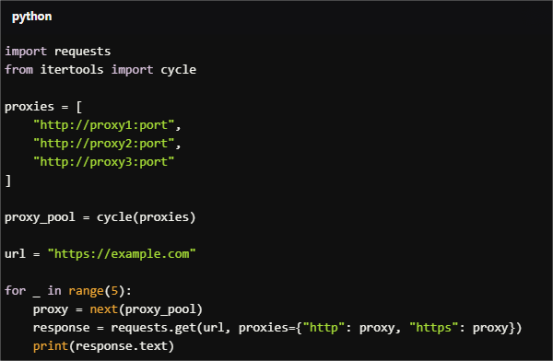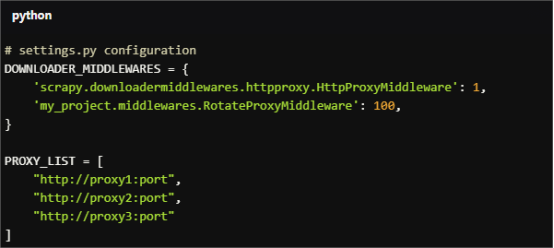Web Crawling vs Scraping: Differences & Proxy Tips
Explore how web crawling and web scraping differ, and learn proxy best practices for reliable, large-scale data collection.
Apr 22, 2025
The Ultimate Guide to rotating proxies, including what they are, their types, comparison with static and sticky proxies, and quick setup.
Maintaining online privacy has become a common demand. Proxy servers serve as intermediaries between users and the internet, offering more than anonymity, for example, bypassing restrictions. Among the various types of proxies, rotating proxies stand out for their effectiveness in safeguarding users and enhancing performance.
In this article, we will explore:

A rotating proxy is a proxy server that automatically changes the IP address at set intervals or after each request. Instead of using a single static IP, rotating proxies assign a new IP from a large pool, making it harder for websites to detect automated activity.
1. A request is sent through the proxy server.
2. The proxy assigns a new IP address from its pool.
3. The request reaches the target website from a different IP.
4. The next request repeats the process with a fresh IP.
| Rotation Type | Description | Best Use Cases |
| Time-Based Rotation | IP changes after a fixed time (e.g., every 5 minutes) | Session-based scraping, social media automation |
| Request-Based Rotation | IP changes after each request or after a predefined number of requests | Large-scale data extraction, ad verification |
| Session-Based Rotation (Sticky Proxies) | Keeps the same IP for a longer session before rotating | E-commerce monitoring, login-based tasks |
Editor’s Tip: We will do a detailed comparison between sticky and fully rotating proxies later in this blog.
1. Web Scraping & Data Mining: Prevents IP bans when extracting large amounts of data from websites.
2. SEO Monitoring: Enables tracking keyword rankings across different locations without triggering CAPTCHA challenges.
3. Ad Verification: Helps verify ads across different regions by constantly changing IPs.
4. Cybersecurity Testing: Simulates attacks from multiple locations to test website defenses.

This is the top reason for using rotating proxies. Large-scale data extraction requires multiple IPs to avoid detection. Rotating proxies ensure continuous access to data-heavy sites.
Websites block scrapers and bots making too many requests from the same IP. Rotating proxies distribute requests across multiple IPs, reducing detection.
Frequent IP changes make it difficult for websites to track your activity. Protects against IP-based fingerprinting and tracking.
Rotating residential proxies use real residential IPs assigned by ISPs. Harder to detect compared to datacenter proxies. Best for bypassing strict anti-bot systems (e.g., Amazon, Google). More expensive but provides high anonymity.
Top Providers: Bright Data, Oxylabs, Smartproxy, GoProxy
Uses cloud-based or datacenter IPs (not linked to real users). Faster and more affordable than residential proxies. Best for bulk data collection and SEO monitoring. Easier to detect than residential proxies.
Top Providers: GoProxy, BlazingSEO, StormProxies
Combines residential trust with datacenter speed. Best for managing social media accounts without bans. Faster than traditional residential proxies but more expensive than datacenter proxies.
Top Providers: Bright Data, Soax
Uses mobile carrier networks (high anonymity). Best for managing multiple social media accounts (Instagram, TikTok). Harder to detect due to carrier-grade NAT (CGNAT). Expensive due to limited availability.
Top Providers: AirProxy, ProxyGuys, Bright Data
Static proxies provide a single dedicated IP address that remains unchanged for an extended period. Useful for activities requiring a consistent online identity.
| Feature | Static Proxies | Rotating Proxies |
| IP Consistency | Fixed IP | Changes frequently |
| Anonymity & Security | Low | High |
| Detection Risk | Higher | Lower |
| Performance & Speed | Faster | May have slight delays |
| Best Use Cases | Social media management, secure browsing | Web scraping, automation |
If you need a stable connection for logging into accounts, choose static proxies.
If you need high anonymity for scraping, choose rotating proxies.
Sticky proxies allow users to maintain the same IP for a longer session while still using a rotating proxy network. They offer a balance between stability and anonymity.
| Feature | Sticky Proxies | Full Rotating Proxies |
| Session Persistence | Keeps the same IP for a session | Changes IP frequently |
| Anonymity | Moderate | High |
| Reliability & Compatibility | More stable for login-based tasks | Better for large-scale scraping |
| Best Use Cases | E-commerce monitoring, ad verification | Data extraction from strict sites |
If you need session-based browsing, use sticky proxies.
If you need rapid IP changes, use fully rotating proxies.
To get started, you need a reliable proxy provider that offers rotating proxies. You can consider the top providers we list above in the Types section. Look for a provider with a large IP pool, fast speeds, and flexible rotation settings.
Most proxy providers allow you to configure how often your IPs rotate. Choose request or time-based rotation as you need.
Editor's Tip: If you need persistent sessions for logging into accounts, use sticky proxies instead of fully rotating proxies.
Once you’ve set up your rotation preferences, your provider will give you the proxy IP & port.
Example format: http://username:[email protected]:8080
Next, you need to configure it in your preferred tool or application. Below are two simple examples:
Example 1. Using Rotating Proxies in Python (requests module)

For Copy:
import requests
from itertools import cycle
proxies = [
"http://proxy1:port",
"http://proxy2:port",
"http://proxy3:port"
]
proxy_pool = cycle(proxies)
url = "https://example.com"
for _ in range(5):
proxy = next(proxy_pool)
response = requests.get(url, proxies={"http": proxy, "https": proxy})
print(response.text)
Example 2. Setting Up Rotating Proxies in Scrapy
Automatically rotates proxies for web scraping.

For Copy:
# settings.py configuration
DOWNLOADER_MIDDLEWARES = {
'scrapy.downloadermiddlewares.httpproxy.HttpProxyMiddleware': 1,
'my_project.middlewares.RotateProxyMiddleware': 100,
}
PROXY_LIST = [
"http://proxy1:port",
"http://proxy2:port",
"http://proxy3:port"
]
Interested in a detailed example? Check our blog “A Beginner’s Guide to Web Scraping in R”.
Regularly check proxy performance to prevent issues like slow speeds, failed connections, or blocked IPs. Key points include success rates, speed & latency, and bans/CAPTCHAs.
To maximize efficiency and avoid bans, follow these key do’s and don’ts:
Do:
1. Use Residential or Mobile Rotating Proxies for High Anonymity
2. Adjust Rotation Frequency Based on Your Use Case
3. Implement User-Agent Rotation & Headers Spoofing
4. Slow Down Requests to Mimic Human Behavior
5. Handle CAPTCHAs with Anti-CAPTCHA Services
Don’t:
1. Using Free Proxies: These are often slow, unreliable, and insecure. Always use a reputable provider.
2. Not Using Session Persistence When Needed: Some tasks require sticky proxies instead of fully rotating ones (e.g., logging into accounts).
3. Sending Too Many Requests Too Quickly: This can trigger bans even with rotating proxies—always throttle request speed.
4. Ignoring Website-Specific Anti-Bot Measures: Some sites use advanced fingerprinting techniques—consider using browser automation tools like Puppeteer or Playwright if needed.
Choose rotating proxies when performing large-scale data extraction or automation tasks requiring high anonymity. Need high-quality rotating proxies? Check GoProxy flexible plans, covering rotating residential & datacenter & 4g proxies, pay as you go. Support both fully automatic and sticky rotation. We also provide unlimited rotating residential proxies for maximum efficiency. Start a free trial today!
< Previous
Next >
 Cancel anytime
Cancel anytime No credit card required
No credit card required